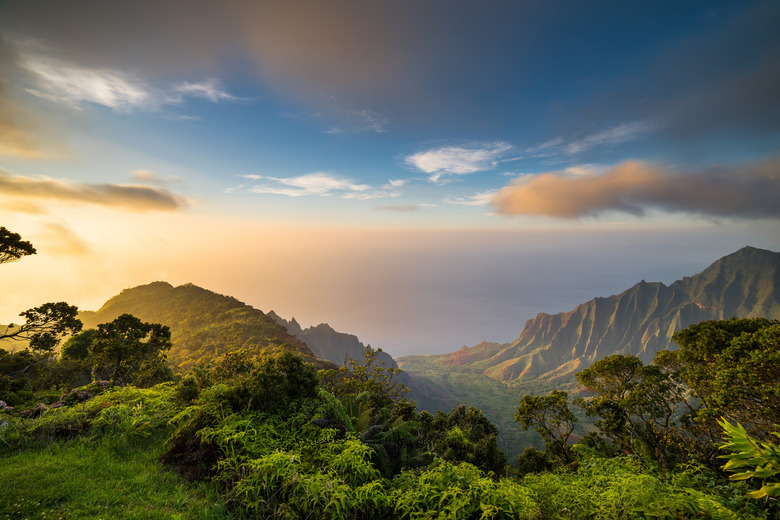Tropical Rain Forest Biome Landscape Features
Tropical rain forests inhabit the equatorial belt, and are characterized by intense sunlight, heat and large amounts of rainfall. The largest forests are found in South America, Central Africa and the Indonesian archipelago. Although rain forests across the world share certain characteristics, rain forest classifications can be further subdivided depending on the amount of rainfall per year. These subdivisions are evergreen rain forest, seasonal rain forest, semi-evergreen forest, and a moist and dry, or monsoon forest. The topography of a rain forest varies from region to region, but all rain forests share certain features of vegetation and ecology.
Rain Forest Canopies
Rain Forest Canopies
All rain forests have four specific layers to their structure. The topmost is the emergent layer. These are trees between 100 to 240 feet in height, have umbrella-shaped canopies and are spaced apart from each other. Under the emergent layer is the canopy, a dense layer of leaves and branches that are 60 to 130 feet high. The canopy absorbs almost all the sunlight. It is this layer that contains more than half of a rain forest's wildlife. Beneath the canopy is the understory that comprises tree trunks and other vegetation that reaches up to 60 feet.
Shrub Layer
Shrub Layer
The shrub layer of a forest grows up to 15 feet high and comprises shrubs, vines, ferns, as well as saplings of trees that will later form the canopy layers of the forest. Vegetation is dense, as each plant and tree competes fiercely for any sunlight not blocked by the canopy. Many nocturnal animals are found in the shrub layer, as well as other species that cross between the shrub and the canopy layers.
Forest Floor
Forest Floor
Only 2 to 3 percent of sunlight reaches the forest floor. The only vegetation that lives here has adapted to low-light levels. The forest floor is littered with leaves and decaying vegetation. Decomposition by bacteria and molds is rapid, and nutrients are quickly recycled into new plant growth. This is due to the poor soil quality of many tropical rain forests. Nutrient layers only exist in a thin topsoil that is replenished by dead plant and animal remains. However, there are rain forests that have rich soils; these are typically areas of volcanic activity where volcanic soils comprise a nutrient-rich base for forest growth. Rain forest topsoil is held together by dense root systems.
Adaptation to Conditions
Adaptation to Conditions
Rain forests are shaped by intense competition for sunlight and soil nutrients; as a result, the physical characteristics of the vegetation reflects that. Tree roots are buttressed to huge proportions so as to support a high trunk and wide branches. Canopy leaves are large to absorb the maximum amount of sunlight, and are layered with wax to remain waterproof in the humid environment; this is to minimize mold growth. Vines and epiphytes are able to proliferate because they are adapted to grow on existing trees to reach available light. Vines and roots dangling from higher vegetation is common in rain forests.
Cite This Article
MLA
Conceicao, Peter De. "Tropical Rain Forest Biome Landscape Features" sciencing.com, https://www.sciencing.com/tropical-forest-biome-landscape-features-8414467/. 22 November 2019.
APA
Conceicao, Peter De. (2019, November 22). Tropical Rain Forest Biome Landscape Features. sciencing.com. Retrieved from https://www.sciencing.com/tropical-forest-biome-landscape-features-8414467/
Chicago
Conceicao, Peter De. Tropical Rain Forest Biome Landscape Features last modified March 24, 2022. https://www.sciencing.com/tropical-forest-biome-landscape-features-8414467/
